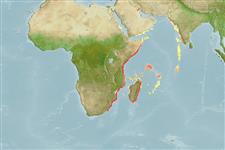Environment: milieu / climate zone / depth range / distribution range
Ecología
marino; agua dulce; salobre demersal; catadromo (Ref. 51243). Tropical
Africa: Kenya to South Africa (Ref. 3506), uncommon south of the Save River (Ref. 7248, 52193). Also Reunion and Mauritius (Ref. 33390). Dominant eel species in the Zambezi system and farther north in East Africa (Ref. 52193).
Tamaño / Peso / Age
Maturity: Lm ? range ? - ? cm
Max length : 175 cm TL macho / no sexado; (Ref. 48660); peso máximo publicado: 20.6 kg (Ref. 52193); edad máxima reportada: 15 años (Ref. 48660)
Espinas dorsales (total): 0; Espinas anales 0.
Migratory species which breeds in the ocean (Ref. 52331), it requires rivers and oceans (Ref. 30558). Young fish migrate upstream with a continued feeding mode, especially on invertebrates found on rocks and logs washed by fast moving waters (Ref. 30558). They inhabit various niches in a river system (Ref. 13337) and penetrate far inland, surmounting formidable barriers in its upstream migration, including the Kariba and Cahora Bassa dams (Ref. 52193). Adults need moving water to migrate back to the ocean, especially after heavy rains (Ref. 30558). Their food consists of crabs, frogs and insects (Ref. 30558), and even fish, including trout in the streams of the eastern highlands of Zimbabwe (Ref. 2478, 52193). Caught with various types of nets.
Life cycle and mating behavior
Madurez | Reproducción | Puesta | Huevos | Fecundidad | Larva
Skelton, P.H., 1993. A complete guide to the freshwater fishes of southern Africa. Southern Book Publishers. 388 p. (Ref. 7248)
IUCN Red List Status (Ref. 130435)
Threat to humans
Harmless
Human uses
Pesquerías: comercial; pesca deportiva: si
Más información
Nombres comunesSinónimosMetabolismoDespredadoresEcotoxicologíaReproducciónMadurezPuestaAgregación para la puestaFecundidadHuevosEgg development
ReferenciasAcuiculturaPerfil de acuiculturaRazasGenéticaElectrophoresesheritabilidadEnfermedadesProcesamientoNutrientsMass conversion
Herramientas
Special reports
Download XML
Fuentes de Internet
Estimates based on models
Preferred temperature (Ref.
123201): 25 - 28.7, mean 27.1 °C (based on 306 cells).
Phylogenetic diversity index (Ref.
82804): PD
50 = 0.5000 [Uniqueness, from 0.5 = low to 2.0 = high].
Bayesian length-weight: a=0.00074 (0.00040 - 0.00138), b=3.18 (3.02 - 3.34), in cm total length, based on LWR estimates for this species & Genus-body shape (Ref.
93245).
Nivel trófico (Ref.
69278): 3.8 ±0.7 se; based on size and trophs of closest relatives
Resiliencia (Ref.
120179): Bajo, población duplicada en un tiempo mínimo de 4.5-14 años (tmax=15).
Fishing Vulnerability (Ref.
59153): Very high vulnerability (90 of 100).
